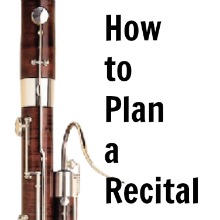Recitals are a lot of work, I admit. But they are necessary if we hope to train future performers. A violinist friend of mine has written a very helpful post about planning a recital. Check out her website for the full rundown and even a free downloadable recital planning checklist. Her post covers finding a venue, hiring accompanists, and a timeline for coordinating everything. I want to add a few more ideas to hers.
Are recitals really necessary?
Yes.
 What if my studio is too small for a proper recital?
What if my studio is too small for a proper recital?
I used to have this problem. The solution was to combine my studio recital with another teacher’s recital. I contacted a few other teachers in my area that I knew had small studios. We combined for a really fun violin/bassoon/piano recital. The violin teacher and I even played a violin/bassoon duet at the end. The students loved seeing the other instruments, and I loved having a recital for my students. I have also been known to hold recitals with five students. They are short! I will always play a piece or two or feature my students in duets or quartets to keep things from being awkwardly short.
What if my students aren’t prepared for the recital?
Usually my students pull it together right before the recital and everything is fine. However, a time or two I have had to switch out music a week before the recital because I could tell they just weren’t going to be ready. I make sure to switch out their unprepared song with a really easy—but fun—song. I do this so the student doesn’t get completely discouraged. They are usually embarrassed enough by how easy it is that they are sure to be prepared for the next recital.
How am I supposed to afford a recital?
You may find that with enough ingenuity you can throw a recital together for free. I hold them in my living room. I can fit about 25 people. Sometimes I have to have two short recitals back to back in order to fit the people in.
If you’re the type that would just rather pay and avoid the stress, then here are some ideas for you:
Charge a Recital Fee – Add up the cost of the venue, accompanists, refreshments, awards, piano tuning… whatever else is associated with your recital, and then divide the total by the number of students in your studio. That is your recital fee. (Btw—I don’t have refreshments, awards, and I am often the accompanist.)
If you invoice monthly, it is easy to tack on your recital fee. If you charge an annual materials fee, you can build the recital fee into that fee. I prefer to build the recital fee into my students’ monthly tuition rate. It results in a dollar or two more per month. I don’t recommend charging admission to your student recitals. You can get into trouble with copyright and the big music licensing companies.
You also don’t have to hold all of your recitals in a fancy venue. This isn’t your wedding reception. It’s a bassoon recital. You may want to hold your last recital of the year in a fancy place. If you do, then hold your others in a retirement home or a community center. Let your venues dictate your repertoire, if need be.
What if I’m still overwhelmed?
You can do this. Start out simple. The first bassoon recital I ever played in was held in my teacher’s small living room, was 20 minutes long, and had five performers. The audience members all piled on my teacher’s couch and kitchen chairs. I mainly remember how fun it was to play with a piano and show everybody what a bassoon could do.
I’m happy to address specific concerns or questions. Please leave them in the comments below!